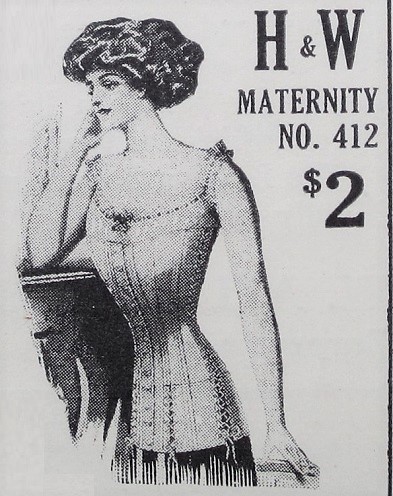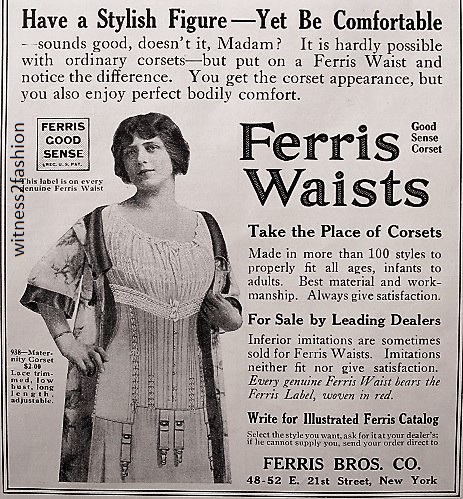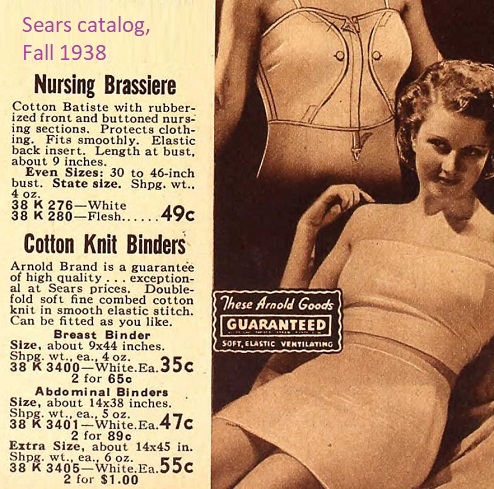
Detail, ad for an H & W maternity corset, Delineator, March 1912. Are they kidding??? No.
Traditionally, fashion rarely made allowances for pregnancy.

Delineator article, April 1912, p. 341.
“New models … have the effect of the uncorseted figure”? Well, not exactly….

Ad for American Lady Corsets, Delineator, March 1912.
That American Lady corset ad above (showing the corset which is under her dress) shows the fashionable figure for 1912 — obviously not a good year to be pregnant if you were a slave to fashion.

Ad for an H & W maternity corset, Delineator, March 1912.
“Gives a trim and stylish figure — without the slightest endangerment to the well-being of either the mother or the child…. Particularly desirable in convalescence or after surgery.”– H&W maternity corset ad, 1912.
My grandmother, born in 1875, was still wearing a long corset like that fashionable “American Lady” when I shared her bedroom in 1950. It was true that women who had grown up wearing corsets did not have well-developed “core” strength — and they certainly couldn’t do sit-ups in one of those corsets! So, they did experience backaches if they tried to go without the support they were used to.
Even when pregnant, they thought they needed a corset. And maybe they did…. I’ve never been pregnant, so reader comments are welcome. You can still buy a stretchy support garment — does it help that aching back?

Lane Bryant (actually, the woman behind the stores was Lena Bryant) was an early — but not the only — company catering to pregnant women in the 1910s.

An ad from Berthe May, January 1914. Delineator. “Allows one to dress as usual and preserve a normal appearance.”

Ad from Lane Bryant, Delineator, April 1914. Lane Bryant specialized in clothing that allowed for an expanding waist.

This 1917 Lane Bryant ad from Ladies’ Home Journal emphasizes that the dress could also be worn after pregnancy. It was “so adapted as to successfully conceal condition.”
There was still a suggestion that pregnancy ought to be concealed — imperceptible — as long as possible.

Lane Bryant maternity corset ad, Delineator, February 1917. “Makes the change imperceptible.”

Maternity corset from the Ferris Waist Co., May 1910. Ferris specialized in corsets made without very much boning — they used more flexible cording instead.

Ad from May, 1914, featuring a maternity corset.

Ferris maternity corset from 1920. Delineator March 1920.
This H & W maternity corset from 1920 promised a “stylish appearance” and “safety for the little one.”

This H & W maternity corset from 1920 shows a more realistic image than the H & W corset from 1912:

H & W maternity corset ad, 1912.
In 1924, you could buy a Butterick pattern and make your own maternity belt / abdominal supporter.

Butterick pattern 5342 for a maternity belt. Delineator, July 1924.
In 1927, Vogue magazine was recommending these:

A bust binder brassiere and maternity corsets shown in Vogue, Oct. 1927.
The Sears, Roebuck catalog for 1930 showed several maternity corsets — in keeping with 1920’s styles — and, yes, a supportive “breast binder.”

A maternity corset and a maternity girdle from Sears, Spring 1930.

Elastic maternity/nursing breast binder and “accouchement band” for post-delivery abdominal support. From Sears, Spring 1930.
They were still around in 1938:

Sears, Roebuck catalog, Fall 1938. Cotton knit binders for breasts and abdomen.

Maternity corsets from Sears, Fall 1938.
In a 1935 article called “Heir Apparent,” Vogue explained the choices in maternity undergarments; by then, corsets were only recommended for women who “habitually” wore girdles or who had weak abdominal muscles.

Advice from Vogue magazine, November 1935.

Maternity corsets from Sears, Spring 1940.
Corsets for abdominal support were also sold for women whose jobs required heavy work — “war work” for many women in factories and munitions plants.

In 1945, Sears was still selling posture supports for women working in “house, farm, or factory.” Sears catalog, Spring 1945. But these are not maternity belts.

Support belts for working women. Sears, Spring 1945.
I didn’t find many maternity corsets in Sears catalogs after 1945 — but perhaps I didn’t look hard enough. Or perhaps in the Post-War baby boom, women no longer felt they had to hide their condition from public view.

Simplicity 4979, 1954. No mention of maternity use on this pattern.

Simplicity 2562, maternity tops from 1958.

Simplicity maternity tops from 1958.

McCall’s 4936, maternity tops, skirt, pants and shorts, 1959.
Quite a change from this “maternity skirt” from 1907:

Maternity skirt ad, 1907.

Any of the corsets that support the bump from underneath would be useful, as a baby plus all the rest is quite heavy. The breast binders, on the other hand, look like they’d cause mastitis – no thanks!
Thanks for this article. So interesting.
I enjoyed reading this. There were still maternity girdles being sold way late into the 1950s. By the early 1960s, they seem to have tapered off, though I’m sure if m’lady so desired one a private corseteire could whip one up for you.
My grandmother was born a year after yours, and she always wore a corset — but not laced up tightly! I think she just felt undressed without it. I cannot imagine that these maternity corsets were a good idea, I wonder if there were problems with wearing them, or if they were sold but not used as the pregnancy advanced. I remember an I Love Lucy episode where she is pregnant, which would have been the early 50s, and she wore maternity tops, so they must have been around a few years by then. Thanks, this was really interesting.
bonnie in provence
Hugging my Grandma was like hugging a warm little barrel, smelling of baking and laundry starch. Her 1890’s “hand span” waist was long gone. My father told me that he incurred her wrath once, after he and my mother took her to a formal banquet. They encouraged Grandma to drink champagne (not part of her usual diet) and had to help her undress when they brought her home. Impatient with untying the corset laces, my father cut them with his pocket knife! (He had been drinking champagne, too.) Poor Grandma didn’t have any spare laces (they were very long) and couldn’t get dressed the next day until someone went out and bought her a pair.
wonderful story! Can you imagine? In very relatively recent times, life was so different…..
bonnie in provence
I have four children and wore a maternity support during my last two pregnancies and can attest that yes they do help with back pain! I also wore a very corset like post partum support after the last two pregnancies as well. While not super comfortable, it was also helpful and both supports were recommended by my doctor. Wearing a corset during pregnancy always sounded like a horrific thing to do until I realized they were probably like the maternity supports we have today. Also a corset would have been a must during pregnancy when they were the primary mode of bust support since breasts get larger and heavier during pregnancy too. The breast binders sound awful at first glance but were probably similar to modern day sports bras.
The elastic ones were like an Ace bandage with straps. I like to wear minimizer bras, which push some of the breast tissue toward the sides while supporting them. The boned breast bandeaux probably did the same. One of the things I learned from 18th c. corsets is how much they support the weight of skirts and petticoats, which make your back ache if the waistbands dig into your waist. Thanks for sharing your practical experience!